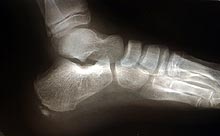Seven Tips to Relieve Heel Pain
Time may heal all wounds. But it takes much more time to heal a heel. Perhaps the biggest mistake that people make is thinking that heel pain is eventually going to go away on its own. Sometimes they wait as long as six months before deciding that they need to see a doctor. But unlike other parts of the body, the foot is weight-bearing, so when the heel is injured, the inflammation persists. Your heel can hurt for any number of reasons. Perhaps the most common is inflammation or tearing of the plantar fascia, a band of fibrous connective tissue that runs along the bottom of the foot from the heel bone across the arch to the toes. This condition, known as plantar fasciitis, can cause pain that radiates from the heel to other parts of the foot. Heel pain can also be caused by everything from poorly fitting shoes to biomechanical problems when you walk or run. Conditions such as tendinitis and rheumatoid arthritis can aggravate the heel as well. Here are some tips that you can consider to adopt to relieve your heel pain. everything from poorly fitting shoes to biomechanical problems when you walk or run. Conditions such as tendinitis and rheumatoid arthritis can aggravate the heel as well. Here are some tips that you can consider to adopt to relieve your heel pain.
1. Loosen Up
A tight heel cord can cause pain in the heel and the arch. Stretching it can relieve a lot of pain and sometimes even make other treatment unnecessary. It is recommended to try out this exercise. Stand at arm's length from a wall. Place your palms on the wall, shoulder-width apart. Step back with your right foot, bending your left knee slightly. Lean toward the wall and drop your right heel to the ground. You will feel some pull or tightness in the back of your right calf. If it is too uncomfortable, move closer to the wall, bringing your right foot in a little bit. Hold the stretch for a count of 10, then switch legs. Repeat the exercise 5 to 10 times per leg. As you do this exercise, be sure not to bounce on your heel. You want a gradual, gentle stretch. Tugging or sudden pulling can injure the tissue.
2. Opt For Orthotics
Orthotics are custom-fitted shoe inserts that can ease your heel pain and perhaps fix the problem that is causing it. Some heel problems have biomechanical origins. Because the foot is not functioning properly, certain parts of it such as the heel have to work harder, which causes them to hurt. A prescription orthotic, given by a doctor, can correct the condition.
3. Mend With Medicine
A nonsteroidal anti-inflammatory drug (NSAID) such as ibuprofen can help reduce any inflammation. Ask your doctor or pharmacist to recommend one.
4. Replace Them Often
A shoe that is worn out won't give your heel the support and shock absorption it needs. You should evaluate a shoe as you would a tire. If the tread goes down or wears out on one side, it is time for a new pair.
5. Go A Little Higher
If you have plantar fasciitis, a heel-raiser may provide some relief. This device, which is sold over the counter in drugstores, inserts in your shoe and raises your heel by 1/8 to 1/4 inch. This takes some of the pressure off the point where the plantar fascia inserts into the heel. This means the plantar fascia has to work less.
6. Run Hot And Cold
Use cold treatments for the first 48 hours after the heel pain starts. It is recommended to simply massage your heel with an ice cube for 5 to 7 minutes, until the area becomes numb. You can do this three to four times a day or as needed.
7. Cushion Your Heel
A heel cushion provides support and protection, which can relieve pain and swelling. This device is available in drugstores, both over the counter and by prescription. There are many kinds, too, from doughnut-shaped to cup-shaped. Which type of cushion you should use depends on the nature of your condition as well as other factors. For this reason, you may want to talk to your doctor or pharmacist before purchasing one.
Raymond Lee Geok Seng is one of the foremost experts in the health and fitness industry and is a writer specializing in body health, muscle development and dieting. He has spent countless of time and efforts conducting research and share his insightful and powerful secrets to benefit men and women all over the world. He is currently the author of the latest edition of "Neck Exercises and Workouts." Visit http://www.bodyfixes.com for more information.
|